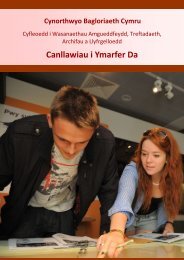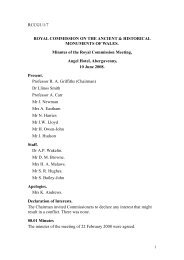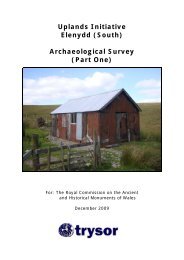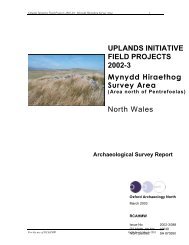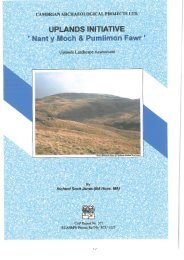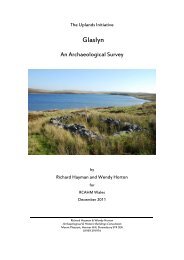Banc y Celyn, Brecknockshire - Royal Commission on the Ancient ...
Banc y Celyn, Brecknockshire - Royal Commission on the Ancient ...
Banc y Celyn, Brecknockshire - Royal Commission on the Ancient ...
- No tags were found...
You also want an ePaper? Increase the reach of your titles
YUMPU automatically turns print PDFs into web optimized ePapers that Google loves.
Uplands Initiative – <str<strong>on</strong>g>Banc</str<strong>on</strong>g> y <str<strong>on</strong>g>Celyn</str<strong>on</strong>g> 20083.4 Post Medieval Industry & Water ManagementFor geological reas<strong>on</strong>s, <strong>the</strong> <str<strong>on</strong>g>Banc</str<strong>on</strong>g> y <str<strong>on</strong>g>Celyn</str<strong>on</strong>g> study area has not historically been suited to<strong>the</strong> development of significant industries. The rocks of <strong>the</strong> area are mostly Silurianmudst<strong>on</strong>es, siltst<strong>on</strong>es and marls, and generally not suitable as building st<strong>on</strong>es. Theyalso do not include any metalliferous ores or o<strong>the</strong>r mineral deposits.It should also be noted that <strong>the</strong>re was very little evidence of turf or peat cutting in <strong>the</strong>study area. There are <strong>on</strong>ly thin peat deposits in limited areas of <strong>the</strong> comm<strong>on</strong>, such as <strong>on</strong><strong>the</strong> eastern end of Cefn Gledwen. Some traces of what may have been turf or peatcuttings were noted <strong>on</strong> Cefn Gledwen (NPRN 247004), but it does not appear that <strong>the</strong>rewas any widespread exploitati<strong>on</strong> of this resource.The <strong>on</strong>ly industrial activity has been <strong>the</strong> small scale quarrying of st<strong>on</strong>e, almost certainlyfor local use, as well as limited use of local lakes and streams as water sources.3.4.1 Quarrying86 quarries and 7 possible quarries have been recorded within <strong>the</strong> study area, but <strong>the</strong>seare all small workings. The quarries tend to be c<strong>on</strong>centrated chiefly al<strong>on</strong>g edge of <strong>the</strong>comm<strong>on</strong> land, and in some locati<strong>on</strong>s <strong>the</strong>y seem to have been worked to provide buildingst<strong>on</strong>e for <strong>the</strong> c<strong>on</strong>structi<strong>on</strong> of <strong>the</strong> walls defining <strong>the</strong> comm<strong>on</strong> boundary. It is likely thatquarrying has been a relatively recent activity, bel<strong>on</strong>ging to <strong>the</strong> post-18 th century period.The sou<strong>the</strong>rn edge of Cefn Llwydallt, at <strong>the</strong> sou<strong>the</strong>astern corner of <strong>the</strong> study area,possesses <strong>the</strong> greatest c<strong>on</strong>centrati<strong>on</strong> of quarries, <strong>the</strong> greyish sandst<strong>on</strong>e of this hillevidently proving to be a more suitable st<strong>on</strong>e than <strong>the</strong> friable, thinly bedded mud andsiltst<strong>on</strong>es found <strong>on</strong> <str<strong>on</strong>g>Banc</str<strong>on</strong>g> y <str<strong>on</strong>g>Celyn</str<strong>on</strong>g>, to <strong>the</strong> north.It is notable that <strong>the</strong>re are very few st<strong>on</strong>e structures in <strong>the</strong> study area, which is probablya reflecti<strong>on</strong> <strong>on</strong> <strong>the</strong> lack of good building st<strong>on</strong>e here. The high number of clearancecairns in <strong>the</strong> area shows that <strong>the</strong> best st<strong>on</strong>e available was usually <strong>the</strong> numerous erraticsmixed into <strong>the</strong> boulder clay that masks <strong>the</strong> hard geology of <strong>the</strong> area.3.4.2 Water SupplyWater management seems to have played an important role in <strong>the</strong> development of <strong>the</strong><str<strong>on</strong>g>Banc</str<strong>on</strong>g> y <str<strong>on</strong>g>Celyn</str<strong>on</strong>g> comm<strong>on</strong>, and numerous, disused, minor leats or drainage channels wererecorded which tapped into mountain streams to carry water. The largest of <strong>the</strong>se wasabove Groes Wen (NPRN 247371) and ran for over 800 metres across <strong>the</strong> comm<strong>on</strong>,although it is not clear where it was intended to carry water to, as it comes to an endwhere it meets <strong>the</strong> substantial earthwork bank NPRN 247368. The ditch still carriessome water and it may be that <strong>the</strong>se, and many of <strong>the</strong> smaller leats, were actually cut toassist with draining some slopes.There is <strong>on</strong>ly <strong>on</strong>e lake in <strong>the</strong> area which was large enough to provide a water supply.During <strong>the</strong> 20 th century, <strong>the</strong> small lake at Pant y Llyn (NPRN 247273) was dammed andslightly enlarged, and an underground water pipe was installed to carry water to <strong>the</strong>west, away from <strong>the</strong> comm<strong>on</strong>, presumably as a domestic water supply.65


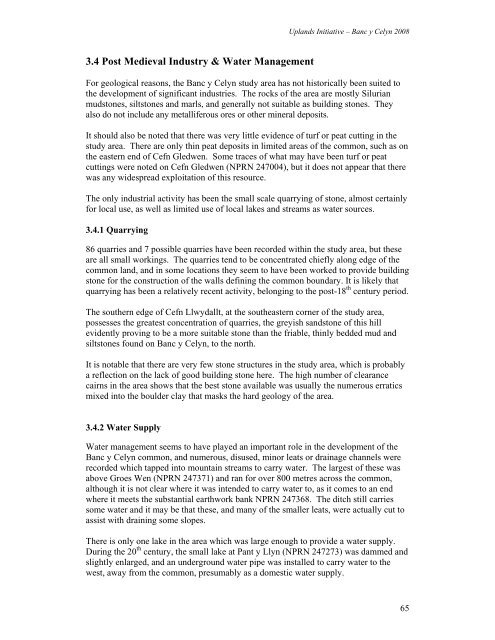

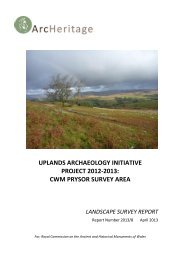
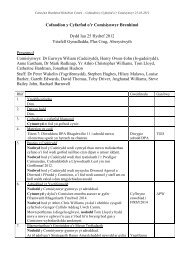

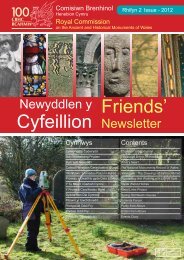
![The Source of the Usk Walk [2012 PDF]](https://img.yumpu.com/49285699/1/190x245/the-source-of-the-usk-walk-2012-pdf.jpg?quality=85)

